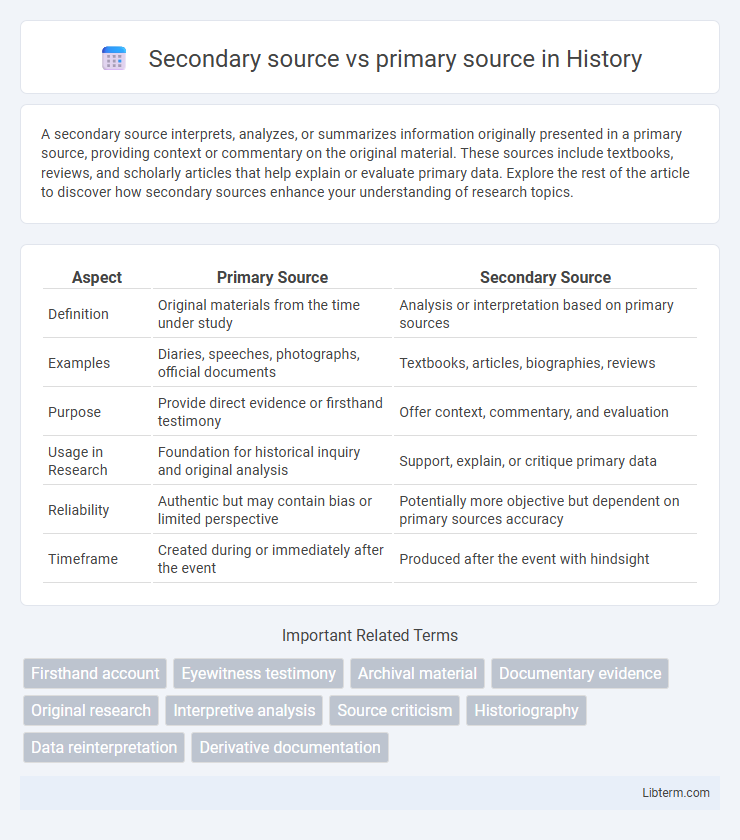A secondary source interprets, analyzes, or summarizes information originally presented in a primary source, providing context or commentary on the original material. These sources include textbooks, reviews, and scholarly articles that help explain or evaluate primary data. Explore the rest of the article to discover how secondary sources enhance your understanding of research topics.
Table of Comparison
| Aspect | Primary Source | Secondary Source |
|---|---|---|
| Definition | Original materials from the time under study | Analysis or interpretation based on primary sources |
| Examples | Diaries, speeches, photographs, official documents | Textbooks, articles, biographies, reviews |
| Purpose | Provide direct evidence or firsthand testimony | Offer context, commentary, and evaluation |
| Usage in Research | Foundation for historical inquiry and original analysis | Support, explain, or critique primary data |
| Reliability | Authentic but may contain bias or limited perspective | Potentially more objective but dependent on primary sources accuracy |
| Timeframe | Created during or immediately after the event | Produced after the event with hindsight |
Introduction to Primary and Secondary Sources
Primary sources provide direct, firsthand evidence or original data related to a topic, such as diaries, interviews, or original research articles. Secondary sources interpret, analyze, or summarize primary sources, including textbooks, reviews, and encyclopedias. Understanding the distinction between primary and secondary sources is essential for accurate research and critical analysis in academic and professional settings.
Defining Primary Sources
Primary sources are original materials providing direct evidence or firsthand accounts of an event, experiment, or time period, such as diaries, official documents, photographs, and artifacts. These sources serve as the foundation for research by offering authentic data that has not been interpreted or altered by others. In contrast, secondary sources analyze, interpret, or summarize primary sources, making primary sources essential for accurate and original scholarly investigation.
Defining Secondary Sources
Secondary sources analyze, interpret, or summarize primary sources, providing context and commentary rather than firsthand evidence. Examples include scholarly articles, reviews, and biographies that evaluate original research or events. These sources help researchers understand the broader implications and significance of primary data within a given field.
Key Differences Between Primary and Secondary Sources
Primary sources provide direct, original evidence or firsthand accounts, such as diaries, interviews, or official documents, while secondary sources analyze, interpret, or summarize primary data, including textbooks, reviews, and articles. The key difference lies in the origin of information: primary sources offer raw data from the time of study, whereas secondary sources rely on primary sources for interpretation and context. Researchers prioritize primary sources for authenticity and secondary sources for comprehensive analysis and broader perspectives.
Examples of Primary Sources
Primary sources include original documents, eyewitness accounts, and artifacts created at the time of an event, such as diaries, letters, official records, photographs, and audio recordings. Examples include Abraham Lincoln's Gettysburg Address, Anne Frank's diary, and the Declaration of Independence. These sources provide direct, firsthand evidence crucial for authentic historical research and analysis.
Examples of Secondary Sources
Secondary sources analyze, interpret, or summarize information from primary sources and include examples such as scholarly journal articles, textbooks, biographies, and reviews. These sources provide critical commentary and contextualization based on original documents, eyewitness accounts, or experimental data found in primary sources. Common secondary materials also encompass encyclopedias, documentaries, and critical essays that synthesize and evaluate primary evidence.
Importance of Identifying Source Types
Identifying source types is crucial for evaluating the credibility and reliability of information, as primary sources provide direct, original evidence while secondary sources offer interpretation and analysis. Accurate classification helps researchers trace the origin of data, ensuring the authenticity and contextual understanding of their findings. Misidentifying sources can lead to misinformation, flawed conclusions, and compromised academic or professional integrity.
Advantages and Limitations of Primary Sources
Primary sources offer direct, original evidence essential for authentic research, providing firsthand accounts that enhance reliability and depth of understanding. They allow researchers to interpret data without intermediaries, capturing context and nuances often missed in secondary sources. However, primary sources may present challenges such as potential bias, limited scope, and the necessity for critical evaluation to ensure accuracy and relevance.
Advantages and Limitations of Secondary Sources
Secondary sources provide a comprehensive analysis and interpretation of primary data, making complex information more accessible and easier to understand. They offer broader context and synthesis from multiple primary sources, enhancing the depth of research without the time-consuming effort of original data collection. However, secondary sources may introduce bias or inaccuracies due to the author's interpretation and lack the immediacy and originality found in primary evidence.
Choosing the Right Source for Research
Selecting the right source for research depends on the purpose and depth of analysis required; primary sources provide original, firsthand evidence such as diaries, interviews, and raw data, essential for detailed, original research. Secondary sources, including scholarly articles, reviews, and textbooks, interpret and analyze primary data, making them suitable for understanding broader context or existing interpretations. Effective research often combines both, using primary sources for direct evidence and secondary sources for critical perspectives and background information.
Secondary source Infographic

 libterm.com
libterm.com